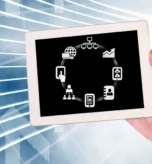How to Select the Right Enterprise Software Development Partner in 2025

In 2025, technology continues to evolve at a breakneck pace. As AI, cloud-native solutions, blockchain, IoT, and low-code platforms reshape enterprise ecosystems, software development is no longer just about building tools—it’s about enabling digital transformation, operational agility, and competitive advantage.
Choosing the right enterprise software development company in this environment isn’t merely a technical decision—it’s a strategic one. The stakes are high. The right partner can drive innovation, future-proof operations, and accelerate time-to-market. The wrong one can leave organizations grappling with delays, spiraling costs, and security vulnerabilities.
This article outlines a comprehensive and forward-looking approach to selecting an enterprise software development partner in 2025. From assessing technological expertise to evaluating delivery models and cultural fit, here’s what decision-makers should keep top of mind.
1. Align on Strategic Objectives First
Before shortlisting vendors, organizations must clarify their own strategic goals. Is the focus on modernizing legacy systems, scaling digital services, improving customer experience, or building AI-driven platforms? The clearer the objectives, the easier it becomes to evaluate potential partners.
Questions to consider:
- What are our business priorities for the next 3–5 years?
- How central is software innovation to achieving them?
- Do we need a partner for one project or a long-term relationship?
Choosing a company with a track record in projects aligned with your strategic intent ensures better alignment, less friction, and faster onboarding.
2. Technical Competency is Table Stakes—But Specialization Matters
In 2025, most reputable software development companies will claim expertise in cloud, AI, DevOps, microservices, and other modern paradigms. The challenge lies in distinguishing those with theoretical knowledge from those with applied experience in your domain.
Key technical considerations:
- Tech stack and frameworks: Do they align with your architectural vision (e.g., event-driven architecture, cloud-native apps)?
- Emerging technologies: Can they deliver real-world solutions using AI/ML, blockchain, AR/VR, or predictive analytics?
- System integration capabilities: How adept are they at integrating with complex enterprise systems?
- Scalability and performance engineering: Can they build resilient systems that scale globally?
Ask for case studies, demos, and reference projects. Prioritize companies that have successfully implemented complex, enterprise-grade solutions in industries similar to yours.
3. Product Thinking Over Project Delivery
The traditional vendor-client dynamic is transactional. A modern software development partner must think like a product owner—balancing user needs, business goals, and technology constraints.
Look for companies that:
- Adopt a product mindset, not just project execution.
- Provide UX/UI design capabilities backed by user research and iterative testing.
- Offer continuous improvement models post-launch, not just delivery and exit.
Agility in development must extend to agility in thinking—does your partner challenge assumptions, propose alternate solutions, and think long-term?
4. Evaluate Software Development Methodology and Delivery Models
Agile has become the default, but not all “Agile” implementations are created equal. Some partners excel in hybrid Agile-Waterfall models suited for regulated industries, while others lean into SAFe or DevOps-first approaches.
Key considerations:
- Delivery model: Do they offer on-shore, off-shore, or hybrid delivery? How does that align with your time zones, regulatory constraints, and collaboration preferences?
- Toolchain and transparency: What project management and collaboration tools do they use (e.g., Jira, Confluence, GitLab)? Will you have full visibility into development cycles?
- CI/CD and DevOps maturity: Are they equipped to automate deployments, testing, and security scans?
- Agile governance: How do they manage sprints, backlogs, scope creep, and stakeholder feedback?
Ask for real-life sprint reports or retrospective formats to gauge maturity. The ability to adjust based on feedback and metrics is a sign of a true partner.
5. Security, Compliance, and Data Privacy Expertise
With regulatory pressure increasing across regions—especially around data privacy and AI—security and compliance are no longer optional. In 2025, software vendors are expected to integrate security throughout the entire software development lifecycle (Secure SDLC) as a foundational practice.
Due diligence checklist:
Do they adhere to internationally recognized information security and data protection frameworks?
Are secure coding practices verified through regular code audits and third-party testing?
Can their infrastructure accommodate varying data residency and localization requirements?
How do they track and manage third-party and open-source components in their stack?
Understand their position on Zero Trust architecture, API management standards, and granular access controls—particularly critical for applications processing sensitive or regulated data.
6. Cultural and Communication Fit
Technology and process aside, successful collaboration boils down to people. A good cultural fit ensures smoother onboarding, better collaboration, and fewer misunderstandings.
How to assess cultural fit:
- Observe communication cadence and responsiveness during initial interactions.
- Evaluate their willingness to challenge ideas constructively.
- Check whether their team dynamics mirror yours—flat vs. hierarchical, formal vs. flexible.
- Test for proactive engagement—do they anticipate problems or wait to be told?
In a hybrid or remote-first world, asynchronous communication, collaborative documentation, and mutual respect become critical success factors.
7. Track Record, References, and Stability
Past performance isn’t always indicative of future results, but it’s a reliable proxy. A mature software development company should be able to showcase:
- Long-term client relationships
- Case studies with quantifiable business outcomes
- Awards, certifications, and industry partnerships
- Client references willing to discuss their experience candidly
It’s equally important to assess their financial health, attrition rates, and founder involvement. Are they likely to remain a stable partner over the lifecycle of your product?
8. Cost Transparency and Value-Based Pricing
In 2025, pricing models are becoming more flexible. Fixed-bid, time & material, and value-based pricing coexist, often with usage-based or outcome-linked elements.
Rather than focusing solely on hourly rates:
- Understand the total cost of ownership, including licensing, support, upgrades, and cloud costs.
- Ask for breakdowns of design, development, QA, and project management efforts.
- Request scenario-based pricing models (e.g., MVP, full-scale product, modular expansion).
Beware of overly low bids. They often signal inexperience or a bait-and-switch model. A transparent pricing structure aligned to business outcomes often yields better long-term ROI.
9. Support, Maintenance, and Post-Launch Services
Software doesn’t stop at launch. Whether it’s patching vulnerabilities, updating dependencies, or rolling out new features, ongoing support is critical.
Look for partners who offer:
- Tiered support models with clear SLAs
- Dedicated maintenance teams that don’t impact core development velocity
- Monitoring and analytics capabilities to measure performance, bugs, and usage patterns
- Change request processes that are fast and traceable
If your internal team will eventually take over, ensure the vendor provides comprehensive documentation, codebase handover, and knowledge transfer sessions.
10. Adaptability to Future Tech Trends
The tools and frameworks you choose today will evolve—or become obsolete. Your development partner must show adaptability and continuous learning.
Traits of a forward-looking vendor:
- R&D investments in emerging technologies
- Contributions to open-source communities
- Partnerships with hyperscalers (AWS, Azure, GCP) or leading SaaS platforms
- A learning culture that encourages experimentation and certifications
Whether you’re looking to explore Generative AI integrations, voice-enabled interfaces, or edge computing, the ideal partner should be eager to explore and guide—not just execute.
Think Beyond Code
In 2025, software development is not just a service—it’s a co-creation journey. The ideal enterprise development partner doesn’t just build what you ask for; they help shape what you need, foresee challenges you haven’t considered, and adapt alongside your business.
Choosing the right partner requires more than a procurement checklist. It demands cross-functional collaboration—between IT, operations, compliance, finance, and leadership—to evaluate potential vendors from multiple perspectives.
The most successful partnerships are rooted in mutual trust, shared values, and a common vision for what technology can achieve. Invest the time to make the right choice—not just for your next project, but for the future of your enterprise.


